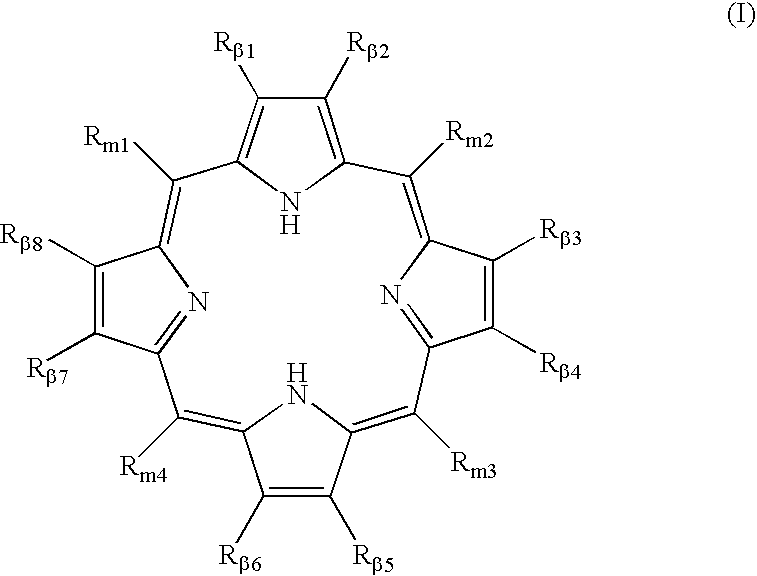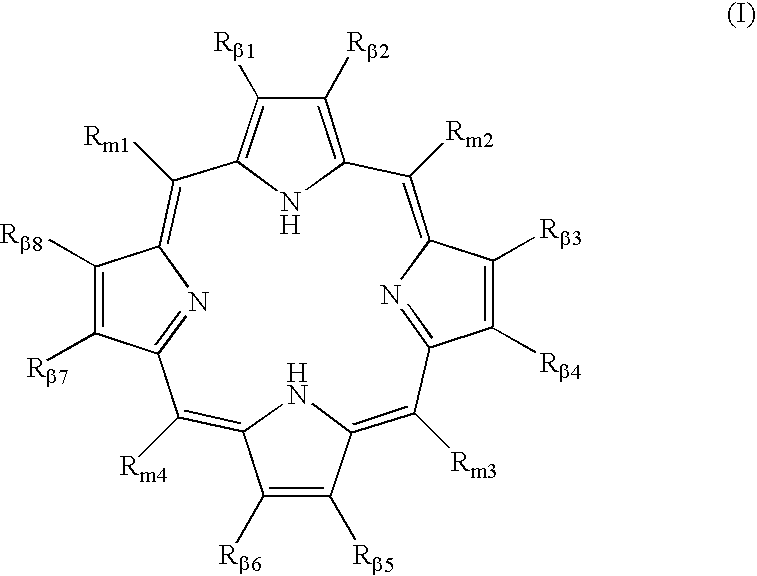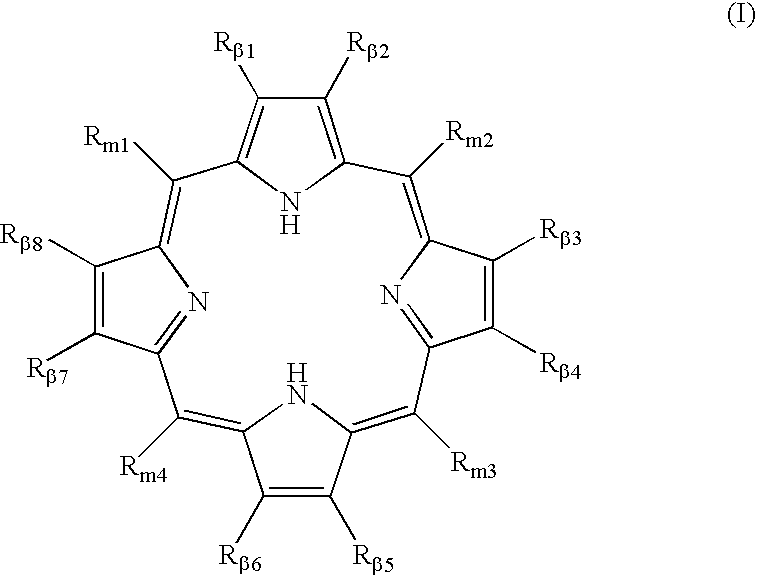Polycarboxylated porphyrins and use thereof in treatment of metal toxicities
a technology of polycarboxylated porphyrins and toxicities, which is applied in the field of polycarboxylated porphyrins and their use in the treatment of metal toxicities, can solve the problems of excessive production of porphyrin intermediates, affecting the effect of oxidative stress, and consuming a lot of succinyl
- Summary
- Abstract
- Description
- Claims
- Application Information
AI Technical Summary
Benefits of technology
Problems solved by technology
Method used
Image
Examples
example 1
Human Porphyrins dissolve Metal-Induced Aβ Aggregates
[0054] Aβ1-40 (10 ng in 200 μl) aggregation is induced by incubation (30 min, RT) with ZnCl2 (25 μM in TBS, pH 7.4), CuCl2 (5 μM in TBS, pH 6.8), or acidic conditions (pH 5.5, MES buffered saline). Aggregates are transferred to a 0.2μ nylon membrane by filtration using a 96-well ELIFA apparatus (Pierce). The aggregates are then washed (200 μl / well) with TBS alone, TBS containing 2 μM EDTA (control), or TBS with uroproporphyrin or coproporphyrin at varying concentrations (0.1 μM-1 mM). The membrane is fixed, probed with the anti-Aβ monoclonal antibody 6E10 (Senetek), and developed for exposure to ECL film. Quantification of retained, aggregated Aβ is performed by densitometry, calibrated against known amounts of the peptide.
[0055] Because metals, such as Zn++ and Cu+, trigger the pathologic aggregation of Aβ, an important causal factor in Alzheimers disease, we tested the ability of endogenous prophyrins to prevent Aβ aggregation...
example 2
Metal Chelation by Endogenous Porphyrins Affects Endogenous Metal Homeostasis and the Toxicity of Heavy Metals
[0056] We studied the interaction between metals and porphyrin intermediates. We demonstrated that the porphyrin intermediates are capable of binding both toxic (Cd, Hg) and physiologic metals (Mn, Zn, and Cu). Results are shown in Tables 1A and 1B.
TABLE 1A+Zn400Dis—IncInc575aDis+Cu==525aDecDec—Dis+Mn=====
[0057]
TABLE 1B+Zn405—Dis—IncDis575aDis+CuInc—Dis525aDisInc—Dis+MnInc460aDis545aDisDis575aDis
Dis; peak disappeared. Inc; Peak increased. Dec; peak decreased. Upor; Uroporphyrin III. Cpor; Coproporphyrin III. (a)indicates new peak. = indicates no difference from the control (raw in bold).
example 3
Porphyrins inhibit β-Amyloid accumulation in Alzheimer's disease transgenic mice
[0058] The affect of human porphyrin intermediates on Aβ aggregation in the APP25576 transgenic (Tg) mouse model of AD, is demonstrated using methodology adapted from Cherny et al, 2001 (below). In this Tg mouse model, the amyloid deposits are enriched with Zn and Fe, resembling amyloid deposits in AD. Tg mice are housed and fed according to standard animal care protocols. The choice of dose of human porphyrins (Cpor I, Cpor III, Upor I and Upor III) is based upon in vitro Aβ aggregation assays. Dosages of 50 mg / kg / d or less are evaluated over the course of 12 weeks.
[0059] The animals are examined daily by a blinded operator, and a measurement of each animal's general behavior in its cage is taken by observation based upon a subjective 5 point rating scale, where 5 is alert, grooming, normal withdrawal response upon handling, and no obvious motor abnormality; 4 is either distressed or lethargic, not gr...
PUM
| Property | Measurement | Unit |
|---|---|---|
| pH | aaaaa | aaaaa |
| pH | aaaaa | aaaaa |
| total volume | aaaaa | aaaaa |
Abstract
Description
Claims
Application Information
 Login to View More
Login to View More - R&D
- Intellectual Property
- Life Sciences
- Materials
- Tech Scout
- Unparalleled Data Quality
- Higher Quality Content
- 60% Fewer Hallucinations
Browse by: Latest US Patents, China's latest patents, Technical Efficacy Thesaurus, Application Domain, Technology Topic, Popular Technical Reports.
© 2025 PatSnap. All rights reserved.Legal|Privacy policy|Modern Slavery Act Transparency Statement|Sitemap|About US| Contact US: help@patsnap.com



